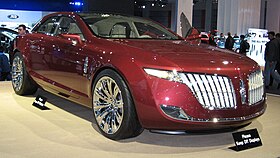
Lincoln Motor Company, or simply Lincoln, is the luxury vehicle division of American automobile manufacturer Ford Motor Company. Marketed among the top luxury vehicle brands in the United States, Lincoln is positioned closely against its General Motors counterpart Cadillac. However, beginning with the 2021 model year, they only offer SUV and Crossover vehicles.
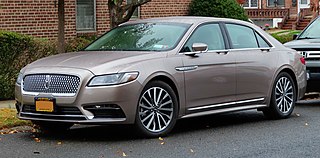
The Lincoln Continental is a series of mid-sized and full-sized luxury cars produced between 1939 and 2020 by Lincoln, a division of the American automaker Ford Motor Company. The model line was introduced following the construction of a personal vehicle for Edsel Ford, who commissioned a coachbuilt 1939 Lincoln-Zephyr convertible, developed as a vacation vehicle to attract potential Lincoln buyers. In what would give the model line its name, the exterior was given European "continental" styling elements, including a rear-mounted spare tire.

The Ford CD3 platform is a Ford midsize car automobile platform. It was designed by Mazda. The platform is designed for either front, all-wheel drive or Ford's hybrid powertrain.

The Ford D3 platform is an automotive platform used by Ford Motor Company for model years 2005-2019, as the fifteenth generation of full-size North American cars.
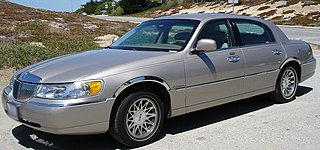
The Ford Panther platform was an automobile platform that was used by Ford Motor Company from the 1979 to 2012 model years. Following the downsizing of the General Motors B-bodies and C-bodies by two years, the Panther platform marked the end of production of sedans unencumbered by downsizing. Originally slated for discontinuation during the early 1980s, the Panther architecture was used for 33 model years, making it one of the longest-produced platforms in North American automotive history.

The Mercury Milan is a mid-size car manufactured by Ford and marketed by its Mercury division of Ford Motor Company — as a rebadged variant of the Ford Fusion. Named after Milan, Italy, Mercury marketed the Milan for model years 2006-2011 in a single generation. The smaller of two model lines developed to replace the Mercury Sable, it indirectly succeeded the Mercury Mystique as the smallest Mercury sedan.

The Lincoln Navigator is a full-size luxury SUV marketed and sold by the Lincoln Motor Company brand of Ford Motor Company since the 1998 model year. Sold primarily in North America, the Navigator is the Lincoln counterpart of the Ford Expedition. It is the heaviest production Lincoln ever built, and is also the Lincoln with the greatest cargo capacity and the first non-limousine Lincoln to offer seating for more than six people.

The Ford Fusion is a mid-size car that was manufactured and marketed by the Ford Motor Company. From the 2006 through 2020 model years, two generations of the Fusion have been produced in gasoline, gas/electric hybrid, and gas/plug-in electric hybrid variants. The Fusion was manufactured at Ford's Hermosillo Stamping and Assembly plant in Sonora, Mexico, alongside the Lincoln MKZ, and formerly the Mercury Milan, both of which share its CD3 platform.

The Cyclone engine, also branded Duratec, is Ford Motor Company's latest DOHC family of gasoline V6 engines introduced in 2006. The Cyclone succeeds Ford's previous V6 engine families, including the Canadian built Ford Essex engine introduced in 1981, the Ford Vulcan engine introduced in 1985, the original Duratec V6 introduced in 1993, and the Ford Cologne V6 engine, whose design dates back to 1962. The first version of the Cyclone engine, a 3.5 L V6, appeared in the 2007 Ford Edge and the Lincoln-badged luxury variant, the Lincoln MKX, as well as the Lincoln MKZ. Mazda badges its versions of the Cyclone MZI as it did with its versions of the Duratec V6.
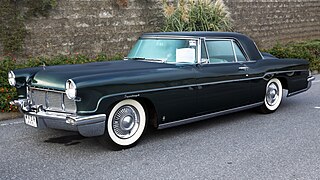
The Continental Mark series is a series of personal luxury cars that was produced by Ford Motor Company. The nomenclature came into use with the Continental Mark II for 1956, which was a successor to the Lincoln Continental of 1939–1948. Following the discontinuation of the Mark II, Ford continued the use of the Mark series on Continental-branded vehicles from 1958 to 1960.
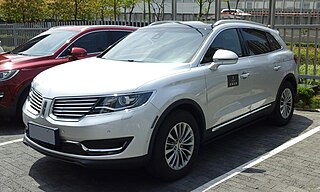
The Lincoln MKX is a mid-size luxury crossover SUV manufactured by Ford Motor Company and marketed its Lincoln brand over two generations, as a rebadged variant of the Ford Edge crossover, for both generations.

The Lincoln MKS is a full-size, five-passenger, front- or all-wheel drive luxury sedan manufactured by Ford and marketed by its Lincoln subdivision for model years (MY) 2009–2016 — over a single generation with an intermediate facelift.

The Lincoln MKZ, is a four-door, five-passenger mid-size luxury sedan manufactured by Ford and marketed as the Zephyr and as the MKZ by Ford's Lincoln brand across two generations in both gasoline and hybrid gas/electric models.

The Ford Interceptor was a concept car that debuted at the 2007 North American International Auto Show in Detroit, Michigan. The Interceptor was a retro-styled full-size sedan that reflected a modern interpretation of the classic sporty American muscle cars from the 1960s, like the Ford Galaxie. Ford officially introduced the Interceptor concept in a company press release dated 31 December 2006. Ford described the Interceptor design styling as being influenced, "...much like a Marine in dress uniform. He looks smart and elegant but you can see the raw power that lies beneath."

The Ford Airstream was a concept car built by Ford that made its debut at the 2007 North American International Auto Show in Detroit, Michigan. The Ford Airstream was a retro-futuristic crossover utility vehicle that was inspired by the classic Airstream recreational vehicle trailers built since the 1930s. The modern Ford Airstream concept included a plug-in hybrid hydrogen fuel cell drive system, called HySeries Drive, that operated exclusively on electrical power. Ford called the Ford Airstream Concept "a futuristic look at crossovers" as "modern touring vehicle(s)" for recreational travelers. The concept vehicle was designed in cooperation with Airstream, a division of Thor Industries. The design and name of the Airstream were possibly influenced by the Ford Aerostar.
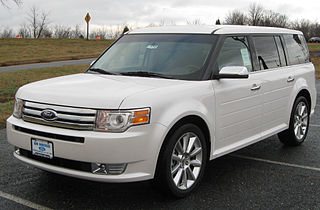
The Ford Flex is a full-size crossover SUV manufactured and marketed by Ford over a single generation from 2009–2019, as the successor to the Ford Taurus X.

The Lincoln MKT is a full-size luxury crossover SUV with 3-row seating marketed by the Lincoln division of Ford Motor Company over a single generation from 2010-2019. Marketed between the Lincoln MKX and the Lincoln Navigator, the MKT shared its Ford D4 chassis with the Ford Flex CUV and the 2011-2019 Ford Explorer.

The sixth generation of the Ford Taurus is the final generation of the model range manufactured by Ford. Introduced for the 2010 model year, the sixth-generation Taurus is the second generation of the model line produced as a full-size car; it was the heaviest sedan sold under the Ford brand worldwide. While sharing its D3 chassis underpinnings with the previous generation, the sixth generation marked the first North American use of Kinetic Design design language.

EcoBoost is a series of turbocharged, direct-injection gasoline engines produced by Ford and originally co-developed by FEV Inc.. EcoBoost engines are designed to deliver power and torque consistent with those of larger-displacement naturally aspirated engines, while achieving up to 20% better fuel efficiency and 15% fewer greenhouse emissions, according to Ford. The manufacturer sees the EcoBoost technology as less costly and more versatile than further developing or expanding the use of hybrid and diesel engine technologies. EcoBoost engines are broadly available across the Ford vehicle lineup.

The Lincoln Nautilus is a mid-size luxury crossover SUV marketed and sold by the Lincoln brand of Ford Motor Company. The Nautilus was initially renamed from the MKX as part of a mid-cycle update in 2018 for the 2019 model year, as Lincoln phased out its use of "MK" model names. The name 'Nautilus' is derived from the ancient Greek word nautes, meaning "sailor," as in nautical or astronaut.
